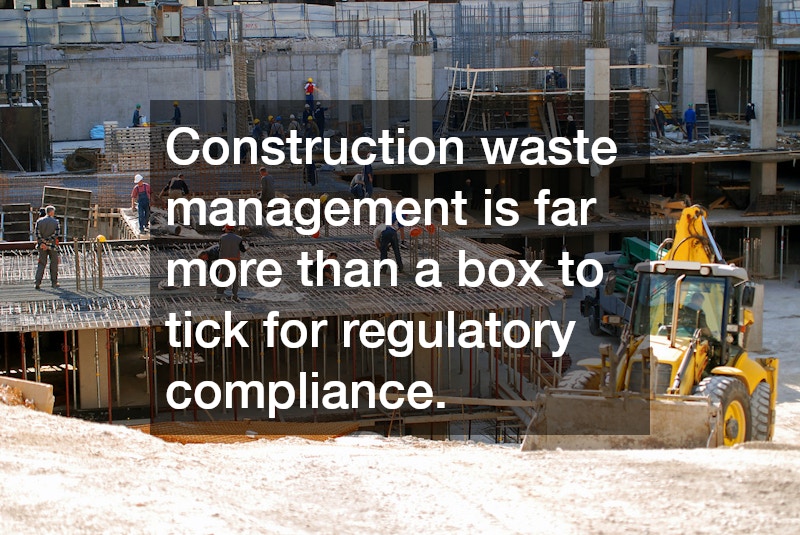Construction waste management plays a vital role in the overall efficiency of any building project. By planning for the handling, disposal and recycling of waste from the outset, construction teams can save time, reduce costs and meet environmental standards. Effective waste management is not only good for the planet but also for a project’s bottom line.
Reducing on-site clutter
A key benefit of proper waste management is keeping the site clear of unnecessary debris. Piles of scrap material, packaging and discarded components can create hazards for workers and slow down operations. When waste is removed promptly and systematically, tradespeople have more space to work efficiently and safely.
Establishing a waste removal routine ensures that work areas remain organised. This reduces the risk of tripping hazards and damage to valuable tools or equipment. A tidy site also reflects a professional approach, which can be important for maintaining a good reputation with clients and regulatory authorities.
Saving time through organisation
Time lost to searching for tools buried under debris or waiting for a clear space to perform tasks can add up quickly. By integrating construction waste management into the workflow, teams can avoid these delays. Clear pathways and designated waste zones mean workers can move freely and materials can be delivered to where they are needed without obstruction.
Additionally, having a waste plan in place reduces the likelihood of last-minute clean-ups before inspections or project handovers. This preparation streamlines operations and helps keep the project on schedule.
Lowering disposal costs
Sending all construction waste to landfill can be costly, especially with rising disposal fees. By sorting waste and separating recyclable materials, construction companies can significantly reduce these expenses. Many recycling facilities offer lower rates for certain materials, and in some cases, contractors can even sell scrap metal, timber offcuts or other reusable components.
Minimising the amount of waste sent to landfill also reduces transport costs. Fewer trips to disposal sites mean less time and fuel spent, which can make a noticeable difference to a project’s budget.
Meeting environmental responsibilities
Environmental regulations are becoming increasingly strict, and failing to comply can result in fines or delays. Construction waste management helps ensure that projects meet these requirements. Proper disposal of hazardous materials like paints, solvents and asbestos is essential for protecting both the environment and the health of workers.
Recycling and reusing materials not only conserve resources but also reduce the carbon footprint of the project. Demonstrating a commitment to sustainable practices can also enhance a company’s standing with clients who value environmental responsibility.
Improving worker safety
A cluttered and poorly managed site can increase the risk of accidents. Sharp objects, unstable piles of debris and slippery surfaces from waste materials all pose dangers. By keeping waste under control, site managers reduce the chance of injuries that could slow down the project or lead to costly workers’ compensation claims.
Safe waste storage and removal procedures protect workers from hazardous substances and ensure compliance with workplace safety regulations. This not only keeps the team safe but also contributes to a smoother workflow.
Enhancing material efficiency
Construction waste management is not only about disposal. It also involves identifying opportunities to reuse or repurpose materials on-site. Offcuts of timber might be used for temporary bracing, while leftover concrete can be used for minor works or fill.
This approach maximises the value of materials purchased and reduces the need for additional orders. Avoiding waste in the first place through accurate measurements and careful planning is another important step in improving material efficiency.
Boosting project reputation
Clients, investors and stakeholders are increasingly interested in sustainable building practices. Demonstrating a clear and effective waste management strategy can enhance a company’s reputation and make it more competitive when bidding for future projects.
A clean, well-organised site leaves a positive impression during client visits and inspections. It also shows that the team is professional, responsible and attentive to details. These qualities can lead to repeat business and referrals.
Supporting regulatory compliance
Many local councils and governing bodies require a documented waste management plan before granting building permits. Having this plan in place ensures compliance from the start and avoids unnecessary delays.
The plan should outline the types of waste expected, the methods for handling each category and the steps for recycling or disposal. Keeping accurate records of waste quantities and disposal methods can also be important for audits or certification processes.
Long-term cost savings
While implementing a construction waste management plan may require an initial investment of time and resources, the long-term savings are substantial. Reduced disposal fees, lower material costs through reuse and avoidance of regulatory fines all contribute to a healthier project budget.
By embedding waste management practices into every stage of construction, companies can ensure that efficiency gains continue across multiple projects. The result is a more sustainable business model and improved project performance overall.
Construction waste management is far more than a box to tick for regulatory compliance. It is a strategic approach that improves site organisation, saves time and money, enhances safety and demonstrates a commitment to environmental responsibility. By planning waste handling from the outset and involving the entire team in the process, construction projects can achieve higher efficiency and better outcomes for all involved.


